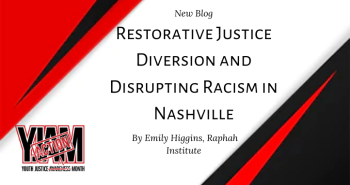Restorative Justice Diversion and Disrupting Racism in Nashville

By Emily Higgins, Raphah Institute
Harmful racial and ethnic disparities (RED), particularly in economic and educational structures, feeds RED in the criminal-legal systems. In turn, RED in the criminal-legal system feeds economic and educational RED, and this destructive cycle becomes imbedded in a family – and in an entire community.
Restorative justice is one way to interrupt this cycle and, thus, reduce harmful RED.
In Nashville, Tennessee, Juvenile Court Judge Sheila Calloway, District Attorney General Glenn Funk, then Public Defender Dawn Deanor, and Police Chief Steve Anderson, turned to restorative justice as a potential solution for addressing defects in the traditional criminal-legal system. In 2017, these system leaders formed a partnership with a local non-profit, Raphah Institute, to launch a pre-petition (pre-charge) Restorative Justice Diversion Program (RJDP). This partnership fits perfectly with Raphah Institute’s mission of partnering with community leaders to design and implement solutions that empower all to heal from harm.
The RJDP focuses on healing both people harmed by crime and young people responsible for crime. Raphah uses Restorative Community Conferencing (RCC), an evidence-based restorative justice model that was developed by Impact Justice. In the RJDP, cases are referred by the juvenile court to Raphah Institute. Then, trained restorative justice coordinators work with the person harmed and the responsible youth to prepare them to eventually have conversations about the harm, its impact, and how to repair it. In this preparation process, youth learn about accountability. However, they also have the opportunity to begin unpacking their personal historical trauma, which almost always is an explanatory factor in their choices. This begins to pave the way for interrupting their own cycle of harm and trauma.
The RJDP is governed by a memorandum of understanding (MOU) between the aforementioned partners. To reduce bias, program eligibility is determined beforehand, and all eligible cases are referred and accepted into the program. Additionally, the RJDP only accepts felony cases, cases that would otherwise be prosecuted by the DA. Furthermore, the cases are referred and accepted prior to the DA filing a petition in the case. Once a young person completes the RJDP, no charges are filed, and the case is resolved.
The result if better for the youth, and for those harmed by crime, and it is a powerful disrupter of the RED cycle.
If you are interested in starting a Restorative Justice Diversion Program in your community, check out A Diversion Toolkit for Communities by Impact Justice.

